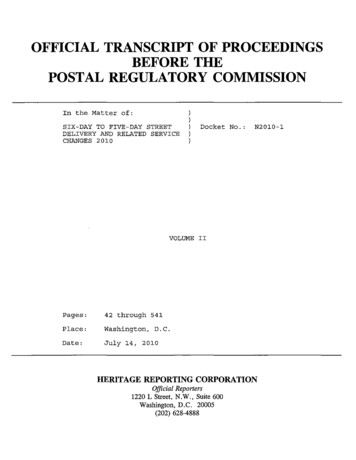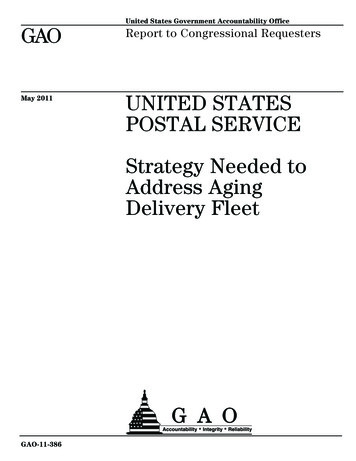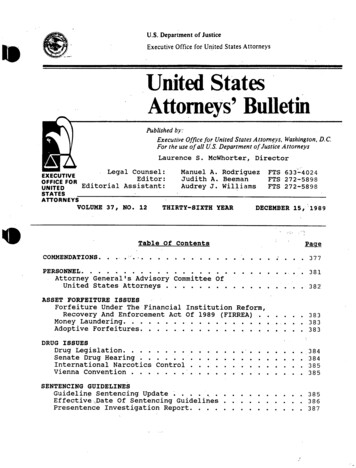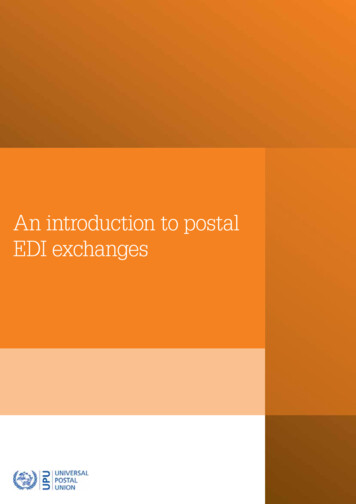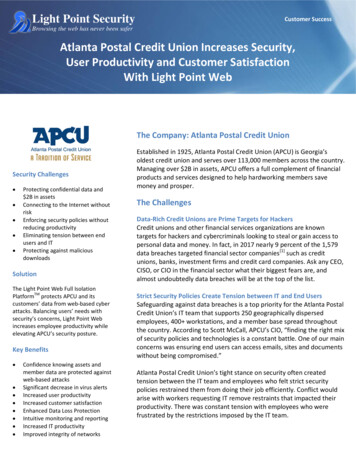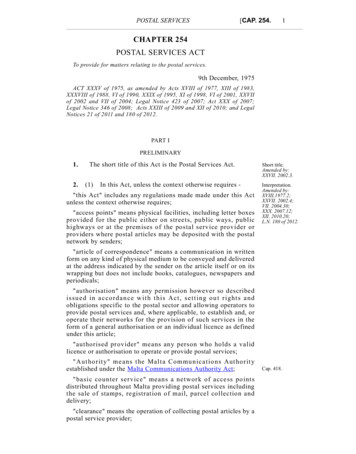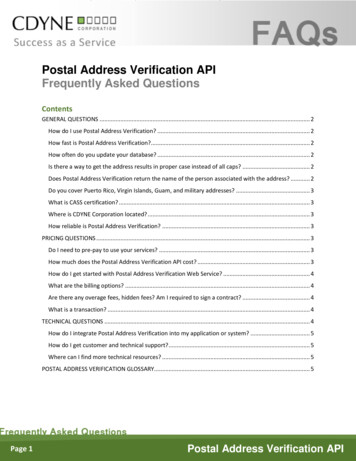
Transcription
United States Postal Service:A Sustainable Path ForwardReport from the Task Force on theUnited States Postal SystemDECEMBER 2018
United States Postal Service:A Sustainable Path ForwardReport from the Task Force onthe United States Postal SystemDecember 4, 2018
DEPARTMENT OF THE TREASURYWASHINGTON, D.C.December 4, 2018The Honorable Donald J. TrumpThe White HouseWashington, DCDear Mr. President:On April 12, 2018, you signed Executive Order 13829, which established the Task Force on theUnited States Postal System to evaluate the operations and finances of the United States PostalService (USPS) and develop recommendations for administrative and legislative reforms for theU.S. postal system. The goal of these recommendations is to identify a path for the USPS tooperate under a sustainable business model, providing necessary mail services to citizens andbusinesses, while competing fairly in commercial markets.The Task Force conducted extensive outreach to stakeholders and performed in depth researchand analysis in order to understand the wide range of challenges facing the USPS.In addition to our August 10, 2018, submission, the Task Force presents here its findings and fulllist of recommendations. We believe these are the first steps forward in creating a sustainablebusiness model under which the USPS can continue to provide necessary mail services for allAmericans.Sincerely,Steven T. MnuchinSecretary of the TreasuryChairman, Task Force on the United States Postal System
Table of ContentsExecutive Summary . 1A.Task Force on the United States Postal System .1B.Unsustainable Financial Path .2C.Scope of Work .3D.Summary of Recommendations .4Introduction. 7A.History of the United States Postal Service .7B.Role of the USPS in the Economy .9C.Current State of the USPS.16D.International Postal Models .29Mission and Business Model . 32A.Historical Business Model .32B.Creation of a New Business Model .33Universal Service Obligation . 39A.Overview .39B.Background .39C.Findings and Recommendations .41Mail and Package Markets . 46A.Overview .46B.Background .47C.Findings And Recommendations .50Operational Structure, Governance, and Long-term Liabilities . 56A.Overview .56B.Background .56C.Findings and Recommendations .60Appendix A – Task Force Recommendations .64Appendix B – Participants List.67Acronyms and Abbreviations .69
Executive SummaryA. Task Force on the United States Postal SystemOn April 12, 2018, President Donald J. Trump created the Task Force on the United StatesPostal System. The Task Force is chaired by the Secretary of the Treasury and includes theDirector of the Office of Management and Budget and the Director of the Office ofPersonnel Management. The Task Force was directed to evaluate the operations andfinances of the United States Postal Service (USPS) and submit findings andrecommendations to the President.The Task Force conducted a robust analysis of the USPS’s operations and finances that wasinformed by an extensive review of information provided by the USPS, academic literature,and industry studies; a review of legislative history and meetings with members of Congressand the Congressional committees of jurisdiction; and meetings with a wide range ofstakeholders. Per the Executive Order, the Task Force studied:i.The expansion and pricing of the package delivery market and the USPS’s role incompetitive markets;ii.The decline in mail volume and its implications for USPS self-financing and theUSPS monopoly over letter delivery and mailboxes;iii.The definition of the “universal service obligation” in light of changes in technology,e-commerce, marketing practices, and customer needs;iv.The USPS’s role in the U.S. economy and in rural areas, communities, and smalltowns; andv.The state of the USPS business model, workforce, operations, costs, and pricing.The recommendations of the Task Force, presented within this document, promotecommerce and communications throughout the United States, without shifting additionalcosts to the taxpayers, and include proposed administrative and legislative reforms to createa sustainable business model for the USPS.Outreach and ResearchThe Task Force met with a wide range of stakeholders representing the USPS workforce;commercial, non-profit, and residential users of the USPS’s services; and the USPS’ssuppliers and competitors. A list of organizations and individuals that provided input to theTask Force in connection to this report appears in Appendix B.1
United States Postal Service: A Sustainable Path ForwardAs directed by the Executive Order, the Task Force consulted with the Postmaster General;the Chairman of the Postal Regulatory Commission (PRC); the Attorney General on issuesrelating to government monopolies operating in the commercial marketplace; the Secretaryof Labor on issues relating to workers’ compensation programs; and state, local, and tribalofficials. The Task Force also conducted a thorough review of data, research, and publishedmaterial from public and private sources, including from the USPS, the U.S. GovernmentAccountability Office (GAO), and the USPS Office of Inspector General (OIG).B. Unsustainable Financial PathThe USPS is a 71 billion enterprise that collects, processes, transports, and delivers 146billion pieces of mail and packages to nearly 159 million households and businessesannually.1 The mission of the USPS is broadly defined via the “universal service obligation”(USO), which is intended to ensure that all citizens and businesses in the United Statesreceive a minimum level of postal services at a reasonable price.The USPS has been losing money for more than a decade and is on an unsustainablefinancial path. The USPS is forecast to lose tens of billions of dollars over the next decade.Further, as of the end of FY 2018, the USPS balance sheet reflects 89 billion in liabilitiesagainst 27 billion in assets – a net deficiency of 62 billion.2The shift toward digital correspondence and the corresponding decline in USPS mailvolumes have been compounded by caps on mail pricing, leading to mail revenue declines ofaround 4 percent per year. Additionally, the USPS has not been able to sufficiently reducecosts to offset declines in revenue, resulting in net losses totaling 69 billion between FY2007 and FY 2018.Although package volumes are increasing due to the rise of e-commerce, package revenuesalone cannot offset the decline in mail revenues. Additionally, as the USPS delivers morepackages, it is competing with private delivery companies and distorting overall pricing in thepackage delivery market.The USPS’s business model – including its governance, product pricing, cost allocation, andlabor practices – was sustainable in an era where mail revenues and volumes grew alongsidepopulation and economic growth. However, as the USPS’s financial condition continues todeteriorate, standalone proposals, such as forgiving the prefunding of post-employmentbenefits or renegotiating labor contracts, will be insufficient. The USPS’s ability to achieveand maintain sustainability over the long-term is dependent upon formative reforms to its12United States Postal Service, Form 10-K for the Fiscal Year Ended September 30, 2018, available -reports/fy2018.pdf.Ibid.2
United States Postal Service: A Sustainable Path Forwardbusiness model that will enable it to flexibly and swiftly adapt to the social, technological,and operational changes in the mail and package markets.C. Scope of WorkThe Task Force’s review of the U.S. Postal System identified significant opportunities forreform that would enable the USPS to operate a sustainable business model and competefairly in competitive markets. The Task Force considered both administrative and legislativereforms that take into account changes in the postal industry, the USPS’s competitiveadvantages, and areas requiring improvement through either government or private sectordriven initiatives. This report provides options that should be considered, in whole or inpart, as the USPS and other stakeholders work to evolve the USPS’s business model andrestore it to the long-term sustainability demanded of it by the American people.The Task Force also considered the USPS’s particular importance to rural and remotelocations within the United States, recognizing the USPS’s role in the U.S. economy, as botha service provider and employer. The USPS provides postal services across all regions and isone of our nation’s largest employers, with employees in nearly every community in thecountry. The Task Force strongly believes that any potential solutions considered shouldnot disadvantage those living in rural or remote locations.Finally, as international mail and packages play a relatively small role in the overall economicperformance of the USPS, representing 3.7 percent of total USPS revenue,3 this report doesnot specifically address issues associated with the shipment and receipt of international mailand packages. However, the Task Force fully supports the August 23, 2018 PresidentialMemorandum that instructed the Secretary of State to seek reforms to the Universal PostalUnion (UPU) to achieve a system of fair and nondiscriminatory postal rates, and stronglysupports the State Department’s October 17, 2018 notice of denunciation that begins theyear-long process of United States withdrawal from the UPU. The Task Force is alsopleased with the October 24, 2018 passage of the STOP Act, which will require the USPS toadopt advance electronic data for international mail shipments in order to help stop the flowof fentanyl, and other illegal shipments, into the United States via the USPS.3United States Postal Service, Form 10-K for the Fiscal Year Ended September 30, 2018, available -reports/fy2018.pdf.3
United States Postal Service: A Sustainable Path ForwardD. Summary of RecommendationsThe Task Force’s recommendations align with the following operating realities of the postalsystem: The volume of First-Class and other mail is in decline; Initiatives must be taken to address both the USPS’s revenues and costs; and Optimizing the unique franchise and monopoly value of the system is necessary.The Task Force recommends that the USPS and Congress work to overhaul the USPS’sbusiness model in order to return it to sustainability. Both administrative and legislativeactions are needed to ensure that the USPS does not face a liquidity crisis, which coulddisrupt mail services and require an emergency infusion of taxpayer dollars. The followingprovides a summary of the Task Force’s recommendations. A full list of recommendationscan be found in Appendix A.GovernanceThe USPS suffers from a lack of institutional governance. The USPS’s Governors areconsidered the “head of the agency” and are responsible for directing and controlling theUSPS. Between December 2016 and August 2018, the USPS Board of Governors (theBoard) had no Governors. In August 2018, the Senate confirmed two Governors – the firstGovernors confirmed by the Senate since 2010. Without Governors, the PostmasterGeneral managed the USPS’s financial and operational challenges without strategic directionand guidance, exacerbating management’s limited power to effect needed organizationalchange. The Board should move to create a new policy mandate that resets the USPS’sorganizational direction and develops financial targets for the USPS. Governance should bestrengthened with expanded Board controls and increased accountability. Moreover, if theUSPS is unable to achieve a sustainable business model and satisfy its financialcommitments, including those to other federal agencies, the PRC should be given strongerregulatory authority to take necessary revenue and expense measures.Universal Service ObligationThe USO is a public policy that defines what citizens and businesses need from agovernment provided postal service, representing a mission statement for a country’s postalsystem. The generally accepted attributes for defining the USO include specifying thegeographic coverage for postal delivery, frequency of delivery, processing standards, modeof delivery, range of required postal products, level of access to post offices, and rules foraffordable postal rates.In the United States, the USO is not clearly defined. For the USPS’s business model toachieve sustainability, the USO must be defined with greater specificity. The Task Forcebelieves that the USO must distinguish between the types of mail and packages for which a4
United States Postal Service: A Sustainable Path Forwardstrong social or macroeconomic rationale exists for government protection in the form ofprice caps and mandated delivery standards (“essential services”), versus those types of mailand packages that are commercial in nature, and therefore would not have a basis forgovernment protection. This definition will provide the USPS and the PRC with aframework to sustainably manage pricing, costs, and products.PricingWith the rise of digital alternatives and the corresponding decline in mail volumes, acrossthe-board rate caps on mail products have become an obstacle to the USPS’s financialsustainability. Although the USPS does have pricing flexibility within its package deliverysegment, packages have not been priced with profitability in mind. The USPS should havethe authority to charge market-based prices for both mail and package items that are notdeemed “essential services.” This will allow the USPS to optimize its income in order tofund its operations, capital expenditures, and long-term liabilities.Cost AllocationThe USPS’s current cost allocation methodology is outdated, leading to distortions ininvestment and product pricing decisions. The USPS’s current cost methodology does nottake into account that market dominant and competitive products operate under differentregulatory and market rules, nor does it capture the cost implications that the rapid decline inmail volume and the rapid rise of package volume have had on the USPS’s cost structure.Modernizing the USPS’s cost standards and allocation methodology is a key principle neededto reform the USPS. This modernization will provide the USPS the information it needs toinform critical management decisions, government policies, and regulatory reporting.Operating CostsIn order to move towards a path of sustainability, the USPS must also address its rising laborand operating costs, including capital expenditures. The USPS’s operating costs are expectedto continue to grow as the country’s population expands, new delivery points are added, andas the requirements for package delivery increase. The USPS must pursue new cost-cuttingstrategies that will enable it to meet the changing realities of its business model. Theseshould include evaluating modifications to delivery processing standards, and the expandeduse of private sector partners in areas such as processing and sortation.Labor ModelIn FY 2018, labor costs accounted for 76 percent of the USPS’s overall operating costs.4Consistent with the President’s Management Agenda to modernize the governmentworkforce, the Task Force recommends that the USPS more closely align wages for both itscareer and non-career workers with those of other federal employees, drawing from likeexamples in the broader labor market.4United States Postal Service, Form 10-K for the Fiscal Year Ended September 30, 2018, available -reports/fy2018.pdf.5
United States Postal Service: A Sustainable Path ForwardRetiree Health BenefitsCongress requires the USPS to fund the retiree health benefits of its employees as part of amandate for postal self-sustainability. The Task Force does not believe that this generalpolicy should change or that the liability for USPS retiree health benefits should be shifted tothe taxpayers. The Task Force believes that this obligation, including the 43 billion in prefunding payments that the USPS failed to pay into the Postal Service Retiree Health BenefitsFund and the unfunded actuarial liability for retiree health benefits, must be restructuredwith the payments re-amortized with a new actuarial calculation based on the population ofemployees at or near retirement age.5New Revenue StreamsThe USPS should explore new business opportunities that will allow it to extract value fromits existing assets and business lines. For example, the USPS should explore licensing accessto the mailbox and providing additional government services, such as licenses for huntingand fishing. The USPS could also capture additional value from its existing retail offices byconverting post offices into contract post offices or by co-locating with or renting space tocomplementary retail establishments. However, given the USPS’s narrow expertise andcapital limitations, USPS should not pursue expanding into new sectors, such as postalbanking, where the USPS does not have a demonstrated competency or comparativeadvantage, or where balance sheet risk would be added.5United States Postal Service, Form 10-K for the Fiscal Year Ended September 30, 2018, available -reports/fy2018.pdf.6
United States Postal Service: A Sustainable Path ForwardIntroductionA. History of the United States Postal ServiceOver the last two hundred years, the United States Postal Service (USPS) has provided“postal services to bind the Nation together through the correspondence of the people.”6The nature of postal services in the United States has varied over time, but has trendedtowards higher levels of service.Early DaysPrior to 1863, there was limited delivery of mail. Americans generally had to pick up mail attheir local post offices. Long lines resulting from Civil War correspondence triggered thestart of free mail delivery in cities and resulted in the first uniform nationwide rate for FirstClass Mail.7 In 1902, after years of pressure from farmers and other rural Americans, ruraldelivery became a permanent service of the Post Office Department.8 The extension of maildelivery to rural Americans prompted calls for the Post Office to deliver packages as well.The 1913 appropriations act for the Post Office Department created “fourth-class mailmatter” that included packages “not exceeding eleven pounds in weight, nor greater thanseventy-two inches in length and girth combined ”9 Within the first six months of offeringthis service, 300 million parcels were delivered.10 Parcel Post, as it was called, spurreddramatic growth of the mail order business, with Sears, Roebuck and Company experiencinga five-fold increase in orders in just one year.111970 Postal Reorganization ActBy the 1960s, the business model for the Post Office Department began to break down.Congress set postal rates and annually appropriated funds for the Department, with 2039 U.S.C. § 101(a).United States Congress. Thirty-Seventh Congress. Session III. Chap. 71 - An Act to amend the Laws relatingto the Post-Office Department (March 3, 1863), Sec. 19, available at: -congress/c37.pdf.8 United States Postal Service, Publication 100: An American History 1775-2006, (November 2012), available 00 024.htm.9 United States Congress. Sixty-Second Congress. Session II. Chap. 389 - An Act making appropriations for theservice of the Post Office Department for the fiscal year ending June thirtieth, nineteen hundred and thirteen, and for otherpurposes (August 24, 1912), Sec. 8, available at: dcongress/session-2/c62s2ch389.pdf.10 United States Postal Service, Publication 100: An American History 1775-2006, (November 2012), available 00 024.htm.11 Ibid.677
United States Postal Service: A Sustainable Path Forwardpercent of the Department’s operating budget coming from a direct taxpayer subsidy.12Postal facilities were woefully out of date, and the low pay for postal employees, mandatedby Congress, meant that many postal employees in urban areas were paid at or near thepoverty level.13,14 Labor relations and modernization failures proved intractable, as there waslittle political will in Congress to provide additional funds for either pay increases or capitalexpenditures.Two examples showcase the magnitude of the problems. In October 1966, the world’slargest postal facility, the Chicago Post Office, was overwhelmed by 10 million pieces of mailand was forced to shut down for three weeks so that it could clear its mail backlog.15 In1970, labor discontent over compensation ultimately led to a “wildcat” strike that involved200,000 postal workers, and only ended after postal management and the NixonAdministration made commitments to provide retroactive raises and legislative reform.16In 1967, President Johnson formed a Commission on Postal Organization, the “KappelCommission,” to examine the Department. The Commission’s findings served as the basisfor the 1970 Postal Reorganization Act (PRA).17 This law (1) created the new USPS as anindependent establishment of the executive branch of the government; (2) established aBoard of Governors, who would select the Postmaster General; (3) directed USPS tobecome a self-funded entity, without a taxpayer subsidy; (4) retained postal employees asmembers of the civil service, but permitted postal unions to bargain over wages and benefits;and (5) established a new Postal Rate Commission to review and make recommendations onpostal rates.182006 Postal Accountability and Enhancement ActThirty years after the PRA, the USPS had again come to a crossroads. As summarized byPresident Bush’s 2003 Commission on the United States Postal Service:12131415161718Report of the President's Commission on Postal Organization entitled "toward postal excellence," (1968)[prepared for] Committee on Post Office and Civil Service, House of Representatives, Ninety-fourthCongress, second session, November 24, 1976, p. 1–6, available at:http://ufdc.ufl.edu/AA00024775/00001/9j.Cordtz, D., “It’s Now or Never for the Post Office,” Fortune, (March 1967), p. 134-136.Chaifetz, Richard I., The Postal Reorganization Act: Applying the Law to the Letter, 12 B.C.L. Rev. 1151 (1971),available at: .Boyd, D., & Chen K., “The History and Experience of African Americans in America’s Postal Service,Chicago: A Postal Shutdown,” Smithsonian National Postal Museum, available ory/p10.html.Ibid.P.L. 91-375, available at: TE-84-Pg719.pdf.Ibid.8
United States Postal Service: A Sustainable Path ForwardThe traditional mail stream will likely continue to migrate to cheaper Internetbased alternatives. Largely as a result, the Postal Service will increasingly findit difficult to meet its “break-even” mandate. [E]ven if postage rates continueto adjust for inflation, the Postal Service, over the next 15 years is likely to runsubstantial deficits. Equally discouraging, these obligations would pile on top ofthe Postal Service’s 92 billion in current debt and other unfunded obligations.Without significant modernization, the Postal Service will have three choices:dramatically roll back service, seek a rate increase of unprecedented scale, or falleven further into debt, potentially requiring a significant taxpayer bailout.19In response to these challenges, Congress enacted the 2006 Postal Accountability andEnhancement Act (PAEA). PAEA made four major changes to the USPS: (1) productswere divided into monopoly (mainly mail products) or competitive (generally packages andexpress mail) products; (2) monopoly product rate increases were capped at the growth ofthe consumer price index for urban consumers (CPI-U); (3) the USPS was given latitude toset rates on competitive products, as long as competitive product revenue met certainminimum cost coverage thresholds; and (4) the USPS was required to begin prefundingaccrued retiree health benefit liabilities.20A goal of PAEA was to push the USPS to find opportunities to improve its finances throughincreased efficiency, rather than through rate increases, thereby mitigating future negativeimpacts from mail volume declines.21 These changes were intended to put the USPS on amore stable long-term footing, given the expectation of declines in mail volumes.B. Role of the USPS in the EconomyThe role of the USPS in the economy is set forth by Congress in federal statute:The Postal Service shall have as its basic function the obligation to providepostal services to bind the Nation together through the personal, educational,literary, and business correspondence of the people. It shall provide prompt,192021President’s Commission on the United States Postal Service, Embracing the Future: Making the Tough Choicesto Preserve Universal Mail Service, (July 31, 2003), available at: icfinance/usps/pdf/freport.pdf.United States Postal Service, Publication 100: An American History 1775-2006, (November 2012), available 00 024.htm.United States Congress. Committee on Government Reform. 109th Congress. 1st Session. Report toaccompany H.R. 22., Rept No. 109-66, Committee Statement and Views, available 09th-congress/house-report/66.9
United States Postal Service: A Sustainable Path Forwardreliable, and efficient services to patrons in all areas and shall render postalservices to all communities.22To fulfill this mission, the USPS provides postal services to commercial, non-profit, andresidential users across all regions of the United States. The USPS has been granted twostatutory monopolies. The first is to carry, collect, deliver, and receive letters over regularpostal routes (the letter delivery monopoly). The second is for the delivery of mail andpackages into mailboxes, effectively granting the USPS exclusive access to mailboxes (themailbox monopoly).23 These monopolies give the USPS exclusive rights to most letterdeliveries and provide it with an advantage in the small package delivery market.Given these monopolies, the USPS is a significant participant in the broader mailing industrythat includes manufacturers, mail preparers, shippers, and other delivery companies.Moreover, the USPS is one of the largest employers in the United States with 634,000 careerand contract workers.24 If it were a private sector company, the USPS would rank 40th inthe 2018 Fortune 500 and 123rd in the 2017 Global Fortune 500.25The USPS as a Service ProviderIn FY 2018, USPS delivered 146 billion pieces of mail to 159 million delivery points,including to rural and remote locations.26 Private carriers charge many of these locations adelivery surcharge, limit the services offered to these locations, and in a few cases, offer noservice at all. No other domestic delivery service comes close to the comprehensive networkand frequency of delivery offered by the USPS.Households are by far the biggest user of the USPS – approximately 83 percent of USPSvolume (mail and packages) is sent either to or from households.27 The most common typeof household mail (62 percent) is advertising mail, which includes promotional and salesmaterial.28 The bulk of ad
A. Task Force on the United States Postal System On April 12, 2018, President Donald J. Trump created the Task Force on the United States Postal System. The Task Force is chaired by the Secretary of the Treasury and includes the Director of the Office of Management and Budget and the Director of the Office of Personnel Management.




